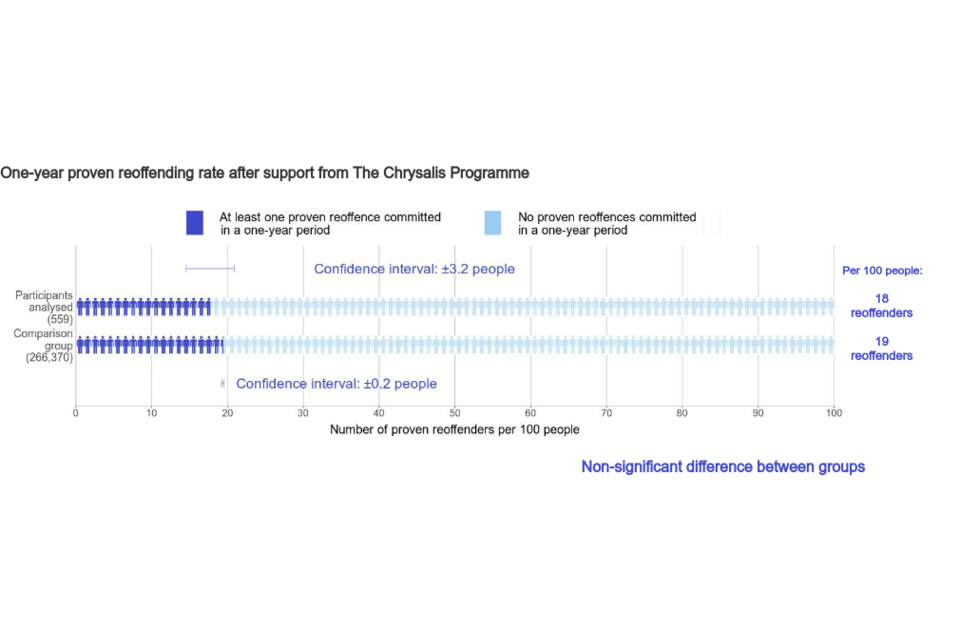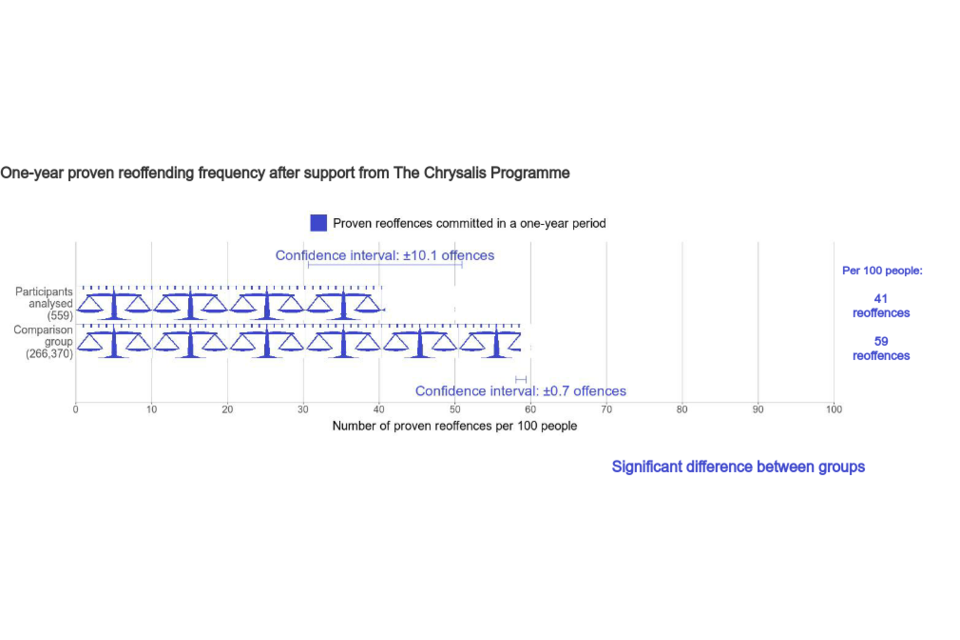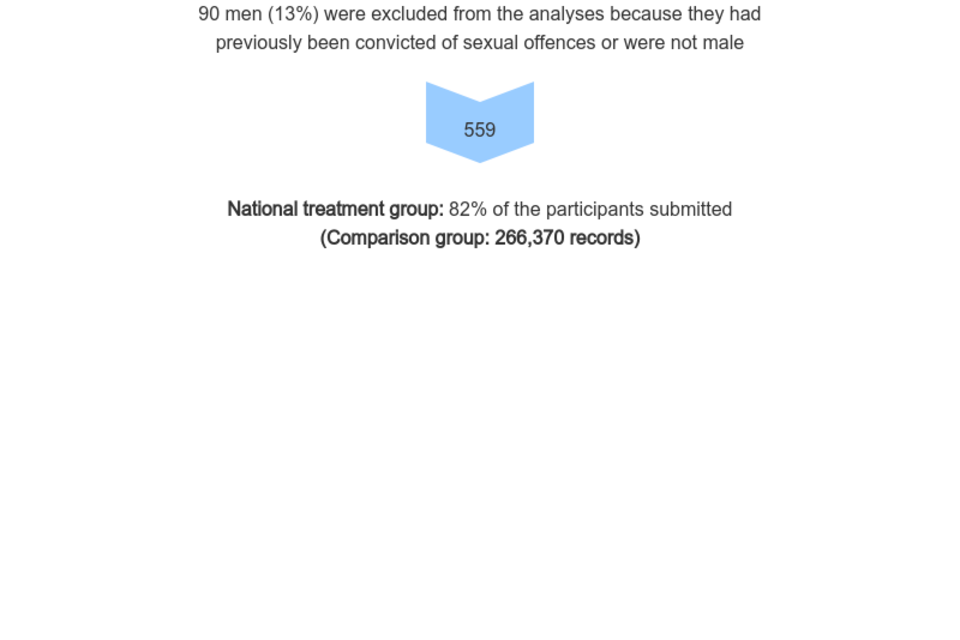The Chrysalis Programme report (HTML version)
Updated 27 April 2023
This analysis looked at the reoffending behaviour of 559 adults who participated in The Chrysalis Programme and includes individuals released from prison between 2012 and 2020. The overall results show that those who took part in The Chrysalis Programme had a lower offending frequency compared to a matched comparison group. This is a statistically significant result. More people would be needed to determine the effect on the rate of reoffending and the time to first proven reoffence.
The Chrysalis Programme is an integrated personal leadership and effectiveness development programme, aiming to reduce reoffending by enabling individuals to drive positive change. They help individuals on custodial sentences with preparation for Parole Board interviews, home detention curfew, release on temporary licence and transfer to open conditions.
The headline analysis in this report measured proven reoffences in a one-year period for a ‘treatment group’ of 559 offenders who received support some time between 2012 and 2017, and for a much larger ‘comparison group’ of similar offenders who did not receive it. The analysis estimates the impact of the support from The Chrysalis Programme on the reoffending behaviour of people who are similar to those in the treatment group.
1. Overall measurements of the treatment and comparison groups
| For 100 typical men in the treatment group, the equivalent of: | For 100 typical men in the comparison group, the equivalent of: |
|---|---|
| 18 of the 100 men committed a proven reoffence within a one-year period (a rate of 18%), 2 men fewer than in the comparison group. | 19 of the 100 men committed a proven reoffence within a one-year period (a rate of 19%). |
| 41 proven reoffences were committed by these 100 men during the year (a frequency of 0.4 offences offences per person), 18 offences fewer than in the comparison group. | 59 proven reoffences were committed by these 100 men during the year (a frequency of 0.6 offences per person). |
| 169 days was the average time before a reoffender committed their first proven reoffence, 16 days later than the comparison group. | 153 days was the average time before a reoffender committed their first proven reoffence. |
2. Overall estimates of the impact of the intervention
For 100 typical men who receive support, compared with 100 similar men who do not receive it:
The number of men who commit a proven reoffence within one year after release could be lower by as many as 5 men, or higher by as many as 1 man. More men would need to be available for analysis in order to determine the direction of this difference.
The number of proven reoffences committed during the year could be lower by between 8 and 28 offences. This is a statistically significant result.
On average, the time before an offender committed their first proven reoffence could be shorter by as many as 5 days, or longer by as many as 37 days. More men would need to be analysed in order to determine the direction of this difference.
Please note totals may not appear to equal the sum of the component parts due to rounding.
3. What you can and cannot say
What you can say about the one-year reoffending rate:
“This analysis does not provide clear evidence on whether support from The Chrysalis Programme increases or decreases the number of participants who commit a proven reoffence in a one-year period. There may be a number of reasons for this and it is possible that an analysis of more participants would provide such evidence.”
What you cannot say about the one-year reoffending rate:
“This analysis provides evidence that support from The Chrysalis Programme increases/decreases/has no effect on the reoffending rate of its participants.”
What you can say about the one-year reoffending frequency:
“This analysis provides evidence that support from The Chrysalis Programme may decrease the number of proven reoffences committed during a one-year period by its participants”
What you cannot say about the one-year reoffending frequency:
“This analysis provides evidence that support from The Chrysalis Programme increases/has no effect on the number of reoffences committed by its participants.”
What you can say about the time to first reoffence:
“This analysis does not provide clear evidence on whether support from The Chrysalis Programme shortens or lengthens the average time to first proven reoffence. There may be a number of reasons for this and it is possible that an analysis of more participants would provide such evidence.”
What you cannot say about the time to first reoffence:
“This analysis provides evidence that support from The Chrysalis Programme shortens/lengthens/has no effect on the average time to first proven reoffence for its participants.”
4. Figure 1: One-year proven reoffending rate after support from The Chrysalis Programme

5. Figure 2: One-year proven reoffending frequency after support from The Chrysalis Programme

6. Figure 3: Average time to first proven reoffence after support from The Chrysalis Programme

7. The Chrysalis Programme in their own words
“Our Vision: To create capability, inspire change and hope.
Our Mission: To engage, educate, inspire and empower individuals to own and drive positive personal change in their lives, creating capability and hope. The Chrysalis Programme is a proven, world class Personal Leadership and Personal Effectiveness Development Programme, that equips individuals with essential life skills, helping them to better own and drive positive personal change in their lives. “There is nothing about a caterpillar that tells you it’s going to become a butterfly.”
How: The Chrysalis Programme addresses the thinking and attitude of participants through the provision of an integrated personal leadership and personal effectiveness development programme; focusing on providing the skills, knowledge and positive mindset that will better enable participants to engage, own and drive positive change in their lives and move away from offending/reoffending. We focus on positive reinforcement and providing participants with ‘what to do’ and ‘how to do it’, enabling them to create positive sustainable change in their lives.
What: We aim to reduce reoffending and effectively re-integrate participants back into their family, communities, employment, society and life.
Who: We aim to work with and support all individuals from tough backgrounds, including those who are disadvantaged or marginalised and those lacking social mobility, namely: those at risk of offending, serving prisoners, returning citizens, those with criminal convictions (ex-offenders) and those on probation.
Our Approach: The innovative Chrysalis Programme aims to provide participants with essential life skills to improve how they manage themselves, as well as how they interact with others. We help participants to think more positively, increase their self-esteem, self-belief, self-confidence and self-motivation. This creates capability and hope. Our philosophy is all about positive reinforcement, learning, development and growth that acts as a catalyst for positive, sustainable, personal change, increasing employability and retention in the workplace. We help people to break out of the ‘cycle of re-offending’ and more effectively re-integrate back into society.”
8. Response from The Chrysalis Programme to the Justice Data Lab analysis
“We at The Chrysalis Programme are pleased that the Justice Data Lab team have completed this analysis of the impact that The Chrysalis Programme can have for those that have successfully completed the programme.
The overall results show that those who took part in The Chrysalis Programme had a lower offending frequency compared to a matched comparison group. This is a statistically significant result.
We are delighted that we are heading in the right direction in helping individuals reduce their levels and/or frequency of reoffending and helping Chrysalis Participants more effectively re-integrate back into society.”
9. Results in detail
One analysis was conducted, controlling for offender demographics and criminal history and the following risks and needs: mental health, thinking skills, attitudes, accommodation, employment, financial management, relationships, drug use and alcohol use.
- National analysis: treatment group matched to offenders across England and Wales using demographics, criminal history and individual risks and needs.
The sizes of the treatment and comparison groups for reoffending rate and frequency analyses are provided below. To create a comparison group that is as similar as possible to the treatment group, each person within the comparison group is given a weighting proportionate to how closely they match the characteristics of individuals in the treatment group. The calculated reoffending rate uses the weighted values for each person and therefore does not necessarily correspond to the unweighted figures.
| Treatment Group Size | Comparison Group Size | Reoffenders in treatment group | Reoffenders in comparison group (weighted number) |
|---|---|---|---|
| 559 | 266,370 | 99 | 104,348 (51,707) |
Three headline measures of one-year reoffending were analysed, as well as four additional measures (see results in Tables 1-7):
- Rate of reoffending
- Frequency of reoffending
- Time to first reoffence
- Rate of first reoffence by court outcome
- Frequency of reoffences by court outcome
- Rate of custodial sentencing for first reoffence
- Frequency of custodial sentencing
10. Significant results
Three measures show a statistically significant result. These provide significant evidence that:
National
- Participants commit fewer reoffences than non-participants
- Participants who reoffend within a one-year period commit fewer triable-either-way offences than non-participants
- Participants who reoffend within a one-year period receive fewer custodial sentences than non-participants
Tables 1-7 show the overall measures of reoffending. Rates are expressed as percentages and frequencies expressed per person. Tables 3 to 7 include reoffenders only.
10.1 Table 1: Proportion of men who committed a proven reoffence in a one-year period after support from The Chrysalis Programme compared with matched comparison groups
| Number in treatment group | Number in comparison group | Treatment group rate (%) | Comparison group rate (%) | Estimated difference (% points) | Significant difference? | p-value |
|---|---|---|---|---|---|---|
| 559 | 266,370 | 18 | 19 | -5 to 1 | No | 0.29 |
10.2 Table 2: Number of proven reoffences committed in a one-year period by men who received support from The Chrysalis Programme compared with matched comparison groups
| Number in treatment group | Number in comparison group | Treatment group frequency | Comparison group frequency | Estimated difference | Significant difference? | p-value |
|---|---|---|---|---|---|---|
| 559 | 266,370 | 0.41 | 0.59 | -0.28 to -0.08 | Yes | <0.01 |
10.3 Table 3: Average time to first proven reoffence in a one-year period for people who received support from The Chrysalis Programme, compared with matched comparison groups
| Number in treatment group | Number in comparison group | Treatment group time | Comparison group time | Estimated difference | Significant difference? | p-value |
|---|---|---|---|---|---|---|
| 99 | 104,348 | 169 | 153 | -5 to 37 | No | 0.13 |
10.4 Table 4: Proportion of men supported by The Chrysalis Programme with first proven reoffence in a one-year period by court outcome, compared with similar non-participants (reoffenders only)
| Number in treatment group | Number in comparison group | Court outcome | Treatment group rate (%) | Comparison group rate (%) | Estimated difference (% points) | Significant difference? | p-value |
|---|---|---|---|---|---|---|---|
| 99 | 104,204 | Either way | 67 | 64 | -6 to 13 | No | 0.52 |
| Summary | 27 | 30 | -12 to 6 | No | 0.49 |
10.5 Table 5: Number of proven reoffences in a one-year period by court outcome for men supported by The Chrysalis Programme, compared with similar non-participants (reoffenders only)
| Number in treatment group | Number in comparison group | Court outcome | Treatment group frequency | Comparison group frequency | Estimated difference | Significant difference? | p-value |
|---|---|---|---|---|---|---|---|
| 99 | 104,204 | Indictable | 0.11 | 0.11 | -0.09 to 0.10 | No | 0.95 |
| Either way | 1.38 | 1.89 | -0.85 to -0.17 | Yes | <0.01 | ||
| Summary | 0.80 | 0.99 | -0.43 to 0.04 | No | 0.10 |
10.6 Table 6: Proportion of men who received a custodial sentence for their first proven reoffence after support from The Chrysalis Programme, compared with similar non-participants (reoffenders only)
| Number in treatment group | Number in comparison group | Treatment group rate (%) | Comparison group rate (%) | Estimated difference (% points) | Significant difference? | p-value |
|---|---|---|---|---|---|---|
| 99 | 104,204 | 54 | 54 | -10 to 10 | No | 0.97 |
10.7 Table 7: Number of custodial sentences received in a one-year period by men who received support from The Chrysalis Programme, compared to similar non-participants (reoffenders only)
| Number in treatment group | Number in comparison group | Treatment group frequency | Comparison group frequency | Estimated difference | Significant difference? | p-value |
|---|---|---|---|---|---|---|
| 99 | 104,204 | 1.32 | 1.75 | -0.82 to -0.03 | Yes | 0.04 |
11. Profile of the treatment group
The Chrysalis Programme is delivered as 6 modules over 5 weeks and is available to all individuals in custody regardless of the type of crime they have been sentenced for; however a security risk assessment is carried out.
A profile of the treatment group is below, the equivalent details for the comparison group can be found in the accompanying Excel annex.
| Participants included in analysis (559 offenders) | Participants not included in analysis (90 offenders with available data) | |
|---|---|---|
| Sex | ||
| Male | 100% | 99% |
| Ethnicity | ||
| White | 56% | 71% |
| Black | 22% | 8% |
| Asian | 20% | 17% |
| Other | 1% | 1% |
| Unknown | 1% | 3% |
| UK national | ||
| UK nationality | 94% | 96% |
| Foreign nationality | 4% | 0% |
| Unknown nationality | 2% | 4% |
| Age | ||
| 21 to 69 years at the beginning of their one-year period (average age 34) | ||
| Prison sentence length | ||
| Less than 6 months | 1% | |
| More than 6 months to less than 1 year |
1% | |
| 1 year to less than 4 years | 36% | |
| 4 to 10 years | 48% | |
| More than 10 years | 7% | |
| Imprisonment for Public Protection | 3% | |
| Mandatory Life Imprisonment | 2% | |
| Other Life Sentence | 1% |
Information on index offences for the 90 participants not included in the analysis is not available, as they could not be linked to a suitable sentence.
For 30 people without any records in the reoffending database, no personal information is available.
Please note totals may not appear to equal the sum of the component parts due to rounding.
Information on individual risks and needs was available for 480 people in the overall treatment group (86%), recorded near to the time of their original conviction.
- 78% had some or significant issues with their problem solving skills.
- 33% had some or significant difficulties coping.
- 42% had some or significant problems achieving goals.
12. Matching the treatment and comparison groups
The analysis matched a comparison group to the treatment group. A summary of the matching quality is as follows:
- The treatment and control groups were well matched.
Further details of group characteristics and matching quality, including risks and needs recorded by the Offender Assessment System (OASys), can be found in the Excel annex accompanying this report.
This report is also supplemented by a general annex, which answers frequently asked questions about Justice Data Lab analyses and explains the caveats associated with them.
13. Numbers of people in the treatment and comparison groups


14. Contact Points
Press enquiries should be directed to the Ministry of Justice press office. Other enquiries about the analysis should be directed to:
Annie Sorbie
Justice Data Lab team
Analytical Priority Projects
Ministry of Justice
10th Floor
102 Petty France
London
SW1H 9AJ
Tel: 07967 592178
E-mail: justice.datalab@justice.gov.uk
General enquiries about the statistical work of the Ministry of Justice can be e-mailed to: ESD@justice.gov.uk
General information about the official statistics system of the United Kingdom is available from https://gss.civilservice.gov.uk/policy-store/code-of-practice-for-statistics/
© Crown copyright 2023
This document is released under the Open Government Licence
Produced by the Ministry of Justice
Alternative formats are available on request from justice.datalab@justice.gov.uk
